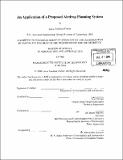| dc.contributor.advisor | Sean George and Brent Appleby. | en_US |
| dc.contributor.author | Fortier, Lucas Jonathan, 1981- | en_US |
| dc.contributor.other | Massachusetts Institute of Technology. Dept. of Aeronautics and Astronautics. | en_US |
| dc.date.accessioned | 2005-06-02T18:34:36Z | |
| dc.date.available | 2005-06-02T18:34:36Z | |
| dc.date.copyright | 2004 | en_US |
| dc.date.issued | 2004 | en_US |
| dc.identifier.uri | http://hdl.handle.net/1721.1/17768 | |
| dc.description | Thesis (S.M.)--Massachusetts Institute of Technology, Dept. of Aeronautics and Astronautics, 2004. | en_US |
| dc.description | Includes bibliographical references (p. 117). | en_US |
| dc.description.abstract | The United States military has always had an increasing need for more accurate airdrops, whether the drops are being implemented for various special operations missions, or for basic humanitarian relief. Improving the delivery accuracy of airdrops will result in numerous benefits. In attempting to improve airdrop accuracy, it is helpful to know what errors will arise throughout the course of a drop. This information is effective in revealing to the airdrop personnel what steps can be taken to improve the airdrop, as well as what the expected landing accuracy of the airdrop will be. This research converges on tools to assist in the estimation and improvement of airdrop landing errors. Wind estimation was studied to better understand the landing errors that stem from different wind prediction methods, as well as from onboard wind measurement systems. Other uncertainties, throughout each phase of an airdrop, are also known to produce landing errors, such as uncertainties in release conditions and parachute dynamics. These errors were implemented in airdrop simulations, for both unguided air release planning systems and guided airdrop systems, to determine the effects of these uncertainties on landing error. Error in wind estimation was found to be the largest source of error in the airdrop simulations. Guided systems were hypothesized to have much smaller landing errors than the unguided systems, and that hypothesis was confirmed in this study. One major benefit of using guidance was the ability to implement onboard wind measurement systems. Using the data from the simulation results, this information was combined to produce an airdrop planning aid to assist airdrop personnel in their aerial deliveries. | en_US |
| dc.description.abstract | (cont.) While the tool developed in this study is not a complete product, it represents a template on which to base further airdrop planning aids. | en_US |
| dc.description.statementofresponsibility | by Lucas Jonathan Fortier. | en_US |
| dc.format.extent | 117 p. | en_US |
| dc.format.extent | 5573286 bytes | |
| dc.format.extent | 5585399 bytes | |
| dc.format.mimetype | application/pdf | |
| dc.format.mimetype | application/pdf | |
| dc.language.iso | eng | en_US |
| dc.publisher | Massachusetts Institute of Technology | en_US |
| dc.rights | M.I.T. theses are protected by copyright. They may be viewed from this source for any purpose, but reproduction or distribution in any format is prohibited without written permission. See provided URL for inquiries about permission. | en_US |
| dc.rights.uri | http://dspace.mit.edu/handle/1721.1/7582 | |
| dc.subject | Aeronautics and Astronautics. | en_US |
| dc.title | An application of a proposed airdrop planning system | en_US |
| dc.type | Thesis | en_US |
| dc.description.degree | S.M. | en_US |
| dc.contributor.department | Massachusetts Institute of Technology. Department of Aeronautics and Astronautics | |
| dc.identifier.oclc | 56528121 | en_US |
